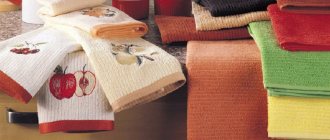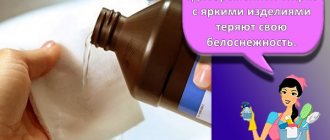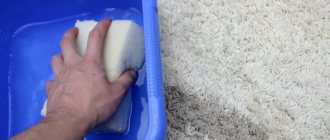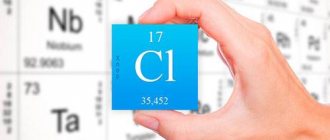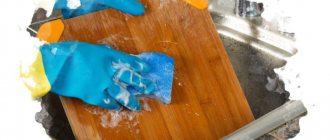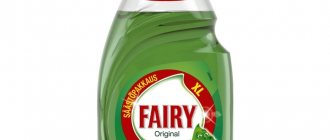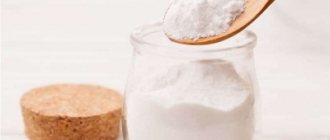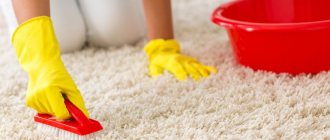White items require special care. Both clothing and home textiles made in white are especially vulnerable to stains. There are a sufficient number of ready-made products for white fabrics on sale, but there are times when they turn out to be ineffective or prohibitively expensive. For such situations, there are time-tested home recipes. The leading position is occupied by bleaching clothes with hydrogen peroxide with the addition of soda and other simple ingredients.
Combination of baking soda, powder
The easiest way to whiten things is to combine NaHCO3, washing powder. Recommended proportions - in equal quantities.
Place the prepared dry mixture into the drum of the washing machine. At hot temperatures, do not get rid of yellowness - sodium bicarbonate works effectively in warm water.
Expert opinion
Attention!
It is recommended to rinse the laundry twice - baking soda can cause irritation to the skin. A thorough rinse with cold water will help prevent the problem.
Stains rarely remain after applying the composition; if yellowness cannot be removed, repeat the process using another recipe based on sodium bicarbonate.
How to bleach white clothes with a mixture of powder, bleach, oil and soda
- What does it cope with? This is a very effective way to combat yellowness and all kinds of stains. The product can remove even very old stains.
- What fabrics is it suitable for? For cotton and linen.
Pour 1 cup (250 ml volume) of laundry detergent, 4 tablespoons of good powder bleach and 1 tablespoon of baking soda into a saucepan.
Pour in 4 tablespoons of sunflower oil. Pour 10 liters of boiling water, stir and put dry things there. The quantity of necessary components can be changed, maintaining the proportions.
Place the pan on low heat for 15–20 minutes and stir the laundry occasionally. Remove from heat and let sit overnight or 6-8 hours. Then wash the items in the machine.
Baking soda, hydrogen peroxide against stains
The combination of NaHCO3 and hydrogen peroxide is used against stubborn stains and yellowing of linen.
Apply the composition carefully - delicate silk fabrics, chiffon, satin can become covered with additional stains.
Anti-stain recipe:
- Mix sodium bicarbonate (30 g), hydrogen peroxide (15 ml).
- Stir until foam forms.
- Cover the stains evenly with the prepared mixture and rub (the process lasts a quarter of an hour).
- Apply the normal cycle using the washing machine.
Washing with a prepared composition will help get rid of yellowness. Instead of powder, use a mixture (peroxide, baking soda).
Carry out the process twice - with a soda solution and regular washing powder.
Advantages of the method
Many housewives have long abandoned popular bleaches in favor of ordinary soda powder, which is found in every home. What is the secret of soda?
- Hypoallergenic. Soda bleaching is safe even for children's clothes, since sodium bicarbonate does not contain aggressive chemical compounds, which often cause severe allergic reactions.
- Versatility. Homemade soda “bleach” can cope with almost all types of stains.
- Availability. Baking soda is easy to buy everywhere, and the price is several times lower than that of “fashionable” bleaches.
Another advantage of sodium bicarbonate is the ability to make a “customized” bleach, depending on the type of fabric being bleached.
You can clean your washing machine using baking soda and vinegar; try the recipes from the following article.
NaHCO3, salt
Common components - NaHCO3, salt - can remove stubborn stains and whiten fabric. It is recommended to carry out a double process - manually, then using a washing machine.
Preparation of the product:
- Mix equal amounts of cooking powder and salt.
- Add warm water (the mixture should be thick and paste-like).
- Spread the mixture in an even layer, completely covering the stain.
- Rub the fabric with your hands.
Recommended for you:
How to remove stains from linen and clothes with soda at home
Yellowness embedded in the fabric can be removed by soaking - a mixture of salt, NaHCO3 (30 g each) diluted with warm water (5 l), immerse the laundry in the composition for 3-5 hours.
Expert opinion
Carefully!
It is not recommended to use salt when machine washing - crystals can damage delicate fabric.
It is better to carry out the process manually after soaking, after which fill the machine tray with a mixture of powder and sodium bicarbonate, and wash the clothes.
When can you use it and when can you not?
Baking soda can be used for hand and machine washing. It is added when boiling clothes to better whiten them. Almost any item can be washed using baking soda.
The exceptions are:
- membrane clothing;
- wool and silk;
- synthetic fabrics;
- leather and leatherette;
- rubberized things;
- velvet, suede, velor.
Cotton and linen items, items made from mixed types of fabric that have a dense structure can withstand washing with soda.
It helps remove the following types of stains:
Wine, coffee, tea- Body fluids, such as blood or sweat.
- Fat.
- Ketchup.
- Grass marks.
- Paint, ink.
- Iodine and brilliant green.
Workwear is often washed with it; it helps to cope with stains from:
- fuel oil,
- kerosene,
- gasoline.
Vinegar, NaHCO3 against stains
Sodium bicarbonate slaked with vinegar is recommended for use only against stains. Handle delicate fabrics with care - the composition is aggressive and can damage fibers and threads.
Preparation and use:
- Pour sodium bicarbonate (50 g) with table vinegar (100 ml).
- Stir until foam forms.
- Use immediately.
Remove stains with foam - spread, rub, leave for a quarter of an hour. Adding NaHCO3 is also recommended in the machine.
Expert opinion
Advice!
You should not often use a product based on NaHCO3 or vinegar - over time, the fabric will wear out, acquire a gray tint, and become thin. Bleaching should be carried out as needed, alternating with the usual use of a good powder.
Disadvantages of Traditional Whitening Products
There are a huge number of whitening products on the market. However, most of the modern remedies have a number of significant drawbacks, so “grandmother’s” soda remedy still remains effective and in demand.
Disadvantages of modern bleaches:
- Aggressive chemicals that cause allergies. Also, such “chemistry” can seriously damage the fabric.
- Fading of some materials. If you didn’t get the dosage right, you can say goodbye to the bright color of your favorite thing.
- Price. Widely advertised bleaches “delight” with a completely undemocratic price, while a solution made from soda will cost you pennies.
- Diversity. Each type of bleach is designed for a specific type of fabric, so to clean things made from different materials (synthetics, cotton, silk, etc.) you will have to pay a significant amount.
Sodium bicarbonate, lemon
It is recommended to use a combination of sodium bicarbonate and lemon against the yellowness of fabric.
Application is possible on delicate fabrics - the composition carefully removes dirt, stains, yellow-gray tint, returning whiteness.
Preparation:
- Cut the citrus, squeeze out the juice (you will need 50 ml), strain using a mesh or fine sieve.
- Combine NaHCO3 (40 g), citrus juice.
- Stir, apply after extinguishing (the appearance of persistent foam).
It is recommended to carry out manual, machine processes, pre-soaking. Remove stains by applying a thick layer of foam - spread and rub with your hands.
When machine washing, add a mixture of washing powder, citrus juice, baking soda to the tray (take equal amounts of components), pre-extinguish the sodium bicarbonate.
Whitening with soda ash
Soda ash is officially recognized as an excellent disinfectant and bleaching agent. The concentration of alkaline compounds in calcined is much higher than in food grade, so it is more often used when washing and bleaching large quantities of laundry.
For whitening with soda ash:
- Take laundry soap and cut a small piece. Grate it on a fine grater - you should get 50-60 g. fine soap shavings.
- Boil 1 liter. water, pour soap into boiling water. Stir until the chips are completely dissolved.
- Add 45 gr. soda ash. Stir thoroughly, during the mixing process you should get a jelly-like mass.
- To add a pleasant aroma, add 2-4 drops of your favorite essential oil to the mixture.
This product is safe both for bleaching items and for hand or machine washing. In addition to whitening, the product removes unpleasant odors well.
Due to the high concentration of alkali, soda ash is only suitable for bleaching items made of linen, cotton and synthetic material. It cannot be used for woolen products and silk.
Read more: “Soda Ash - Application.”
Sodium bicarbonate, laundry soap
At home, to whiten bed linen, it is recommended to use a mixture of NaHCO3 and laundry soap. The composition is used by boiling, in a machine.
Preparation:
- Using a grater, turn the dark laundry soap (bar) into a paste.
- Add baking soda and stir.
- Fill with hot water (1 l).
- Stir with a wooden stick, wait until the soap grains disappear and foam appears.
Recommended for you:
How to use soda against aphids: in the garden, in the garden, at the dacha
Dilute hot water (5-7 l) with a soda-soap solution and fill the boiling container. Pre-soak white items and use lemon soda.
After soaking, boil the bed linen for half an hour, stirring. Rinse and machine wash if necessary.
How to wash faded items
Before you bleach your laundry with soda and peroxide when other things have stained it, you need to learn the basic rule: you need to get rid of dirt as quickly as possible. The first remedy is repeated washing with the addition of a double portion of a special detergent for washing whites, strengthened with soda ash (in a ratio of ten to one). If this method did not help or the color damage was not detected immediately, there are more radical methods:
We recommend:
How to clean suede boots at home
- Cotton linen can be boiled with the addition of hydrogen peroxide and ammonia. For a bucket of water you need a glass of hydrogen solution and 15 milliliters of ammonia, the boiling time should be up to half an hour;
- You can try to revive linen, denim, thick cotton with the help of soda paste. The water-soda slurry is applied to the stains locally, left for 20 minutes, after which the entire item is sent for washing;
- synthetic fabrics can be saved with soapy water. To do this, dissolve a crushed piece of laundry soap in half a liter of water, add two tablespoons of peroxide and five ammonia. The finished mixture is poured into a bucket of warm water, where the faded synthetics are soaked for half an hour before washing.
Note! None of the given recipes are guaranteed to work. The item may not be washed to its original snow-white state. In this case, the only way is to dye the clothes a different color using ready-made dyes.
Sodium bicarbonate, ammonia
The combination of NaHCO3 and ammonia is used to bleach underwear - the composition is gentle on the fabric. Getting rid of stains is carried out in two stages - soaking and rolling in a machine.
Preparation:
- Combine sodium bicarbonate (60 g), ammonia (30 ml).
- Stir, wait a quarter of an hour.
- Combine hot water (5 l), prepared soda mixture.
- Cool, lower underwear, rub with hands, leave.
After 2-4 hours, rub it again with your hands, put it in the washing machine, and turn on the gentle mode.
Double rinsing and using aromatic rinses will get rid of the smell of ammonia.
Precautionary measures
Precautions to take when using baking soda:
When washing by hand, you need to use gloves so as not to dry out the skin of your hands. This is especially true if they have small cracks or scratches.- Do not wash delicate fabrics, such as wool or silk, with baking soda.
- Be careful not to get the powder into your eyes. If this happens, they need to be washed with plenty of water.
- The pack is stored tightly closed in a dry place. If moisture gets in, the baking powder will clump.
- The higher the water temperature, the more active sodium bicarbonate manifests itself. In hot water, its bleaching ability is enhanced. This must be taken into account when washing colored and dark fabrics.
Baking soda, citric acid
Expert opinion
Attention!
A mixture of sodium bicarbonate and citric acid is used against stains, persistent yellowness, and gray tints of fabric. White clothes are also washed with a rather aggressive composition. Do not use the mixture on thin fabrics - there is a risk of damage to the fibers.
Preparation:
- Combine NaHCO3, citric acid (equal proportions).
- For 100 gr. dry mixture - 5 liters of water.
- Stir, put in clothes, leave for 3 hours.
Carry out a manual process. It is recommended to additionally rub stains on clothing with a mixture of cooking powder and acid, pre-moistened with warm water. The consistency should resemble a thick paste.
Machine wash using dry composition (NaHCO3, acid) placed in a tray. Choose a gentle mode, temperature – no higher than 40 degrees.
What types of fabrics can you use baking soda with?
- Sodium carbonate exhibits its properties best when washing clothes made from natural fabrics - linen and cotton. This makes it an ideal tool for cleaning quickly soiled home textiles - tablecloths, towels, bed linen.
- Woolen and silk materials cannot be bleached with soda, as they do not tolerate an alkaline environment. In it, fabrics become rigid and quickly lose their attractive appearance. It is impossible to predict the effect of alkali on synthetics, so it is better not to take risks. These items can be easily washed with standard detergent.
It is prohibited to use sodium salt for rubberized and impregnated materials, leatherette and membrane surfaces.
Soda ash is freely used for colored products, but in small concentrations. Maximum permissible norm: per 10 liters of water - 5 tbsp. l. powder. The liquid should be of moderate temperature - up to 40 degrees.
Secrets of using soda solutions
Sodium bicarbonate is an aggressive substance that can damage sensitive skin, cause an allergic reaction, rashes, and itching.
Rubber gloves will help prevent troubles - apply soda products after protecting your hands.
Sodium bicarbonate is more gentle on tissues than chemicals offered in stores, but people are often allergic to cooking powder.
Recommended for you:
How to clean a microwave with baking soda at home
Rinsing twice with cold water will help prevent troubles - the liquid will completely eliminate particles of the substance remaining after washing.
Alternation will help improve the results of using soda solutions. It is recommended to use different formulations for each whitening session.
Also change the methods of getting rid of yellowness, dirt, stains - soaking, hand washing, machine washing.
How to prepare fabrics for bleaching
Stains on white always appear - as luck would have it, the collar of a shirt gets rubbed, kitchen towels get dirty very quickly, nasty yellowing forms under the armpits of blouses, and after several washes bed linen loses its original shine. Don’t rush to give up your favorite but damaged white clothes - they can be saved without even going to the dry cleaner.
You may be interested in: How to clean an automatic machine with soda from scale, mold and dirt - preventive measures
Things need to be prepared for bleaching. First, try the chosen method on a small area of fabric to understand how it reacts to soda with additives. In the meantime, check out the proven washing rules:
- Very dirty items should be pre-soaked in washing powder for several hours.
- Study the labels on clothing - there is useful information about what means and techniques are contraindicated.
- Never wash white clothes together with colored ones, even if you think they won't fade.
- Try not to boil things often, as this will make them lose their strength and appear old. Do not bleach the fabric every time you wash it.
- If possible, dry white items in the sun.
- Bleach fabrics of different compositions separately.
Every experienced housewife knows these simple truths; they allow you to use things for a long time and keep them in excellent condition.
Don't rush to part with your favorite things, they can be saved with soda
Features of bleaching things made from different materials
The principle of action and the final result of one composition differs for different fabrics. To bleach laundry effectively at home, you need to consider the type and characteristics of the material.
Synthetics
Synthetic fabrics lack natural fibers, which makes them durable and resistant to many chemicals. To wash synthetics, you can use oxygen bleaches or prepare a solution of table salt. 500 g of salt is dissolved in 10 liters of water, things are soaked for 4 hours.
To maintain whiteness, you need to follow the rules when caring for things:
- Sudden changes in water temperature lead to fading of the fabric and the formation of creases. Products are washed at a temperature of +40…+50°C. It is not allowed to soak things in boiling water and boil them.
- Products marked “for synthetic fabrics” are selected for washing. Do not bleach with chlorine products.
- After bleaching, the items are thoroughly rinsed, shaken without squeezing, and dried in the shade.
- Synthetics wear out quickly. White items should be washed every 1-2 days, bleached every 5 washes.
- When bleaching, you should not mix items made from natural and synthetic fabrics.
- Washing and soaking are performed in plastic basins. Metal utensils are not suitable.
Cotton and linen
Cotton and linen fabrics shrink, so you should not use hot water when washing. Fabrics can be washed well at a temperature of +40 °C.
How to restore whiteness to linen items:
- Borax (sodium salt of boric acid) will help preserve the color of bleached flax. Clothes are left in warm water for 30 minutes, then washed with acid added.
- To remove gray deposits on bleached linen, prepare a solution of washing powder and 0.5 cups of turpentine. Things are soaked for 2 hours, then washed. Unbleached flax is rinsed in water with the addition of a small amount of vinegar.
- Ammonia removes yellowness well. Add 1 tbsp to 1 liter of water with powder. l. alcohol and soak things for several hours.
- The dark gray tint can be removed using a mixture of powder and persalt. Flax is soaked in the solution for 12 hours.
- For bleaching, use a weak solution of 7% vinegar. The laundry is soaked for 2 hours, then washed in the usual way.
Cotton items are soaked in a warm solution of chlorine bleach for an hour. 100 g of product is poured into 10 liters of water. Periodically, turn the laundry over, knead it a little with your hands, then wring it out and put it in the washing machine.
Wool and silk
When caring for delicate fabrics, do not use chlorine-containing compounds or products with active bioadditives - enzymes. Sunlight, high temperatures, various alkalis and acids also have a destructive effect on fabric fibers.
Woolen items should not be soaked for more than 1 hour, because their fibers swell in a humid environment, become weak to tear, break and tangle, forming a loose fiber-like layer (pellets) on the surface. Things should not be rubbed; they should not come into contact with each other during bleaching.
Natural brighteners for delicate fabrics:
- Mix 2 parts of hydrogen peroxide and 1 part of ammonia, then add the liquid to water. Soak things in the resulting solution for 1 hour. Then put it in the washing machine, setting the gentle wash mode.
- Dilute 3 tbsp in hot water. l. salt, add 5 drops of ammonia and 1 tbsp. l. hydrogen peroxide.
- Yellow sweat stains are treated with a cotton swab dipped in alcohol.
- Stubborn stains can be removed with baking soda. To do this, mix 2 tbsp. l. soda and a few drops of ammonia so that the mixture turns out to be a paste. The resulting mass is rubbed with a gauze swab into the contaminated area.
- Lace silk underwear can be bleached with lemon juice. Dilute 150 ml of freshly squeezed juice into 1 liter of hot water and let it brew until the water cools. The laundry is soaked for 2 hours.
In some cases, for wool and silk fabrics, oxygen-containing bleaches or special compositions for restoring whiteness based on sodium hydrosulfite can be used. When bleaching, it is necessary to observe the temperature regime, dosage of the product, rinsing and spinning conditions. The duration of action of bleaching agents should not exceed 6 minutes at a water temperature not exceeding +35°C.


